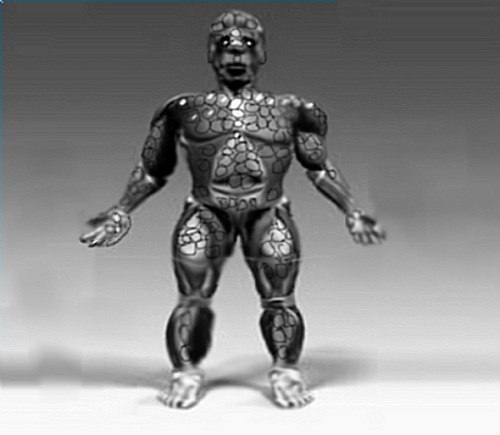BY LETTER
Vacc-Suckers
 Image from Steve Bowers |
The Vacuum Capable Modified Humans, or Vacc-Suckers as they were later called, were a failed clade of early Solsys Era tweaks designed to operate in open space without protection. They were created in 310 AT (AD 2279) by a small startup corporation called Lifetech operating out of earth's L4 point, who planned to breed a dozen or so VCMHs. Unfortunately, behavioral and ethics problems plagued the project until it was shut down by a European Federation task force.
The first VCMHs stood about a metre and a half tall, were hairless with a lot of bone and muscle mass around their chests to shield their vital organs, and had jet-black skin covered in large enamel plates. This made them bulky and slow and they looked quite freakish to many Earthers who were already wary of radical genetic engineering. The Vacc-Sucker's bodies made it difficult for them to breath in a normal oxygen environment and because of the hard plates; sensation was sparse and sexual stimulation almost impossible.
Unlike many tweakers of this era, Lifetech's approach wasn't very radical. Their work on the VCMH's genome emphasized gross physiological changes without the brain development to back them up. Also due to the fairly primitive genetic engineering techniques involved, the Vacc-Suckers were unable to breed.
The company was able to produce 13 VCMHs using surrogate mothers from Cambodia. Unfortunately, seven of the thirteen surrogates died during childbirth. This created a scandal when Lifetech was brought to court a year later. A case that Lifetech won thanks to a widely disliked corporate surrogate law (this was another nail in the coffin of corporate surrogacy laws).
The childhoods of the first thirteen Vacc-Suckers were uneventful. They matured largely as planned, able to live and work in space for short periods of time with no more protection then a pair of goggles. It was when they hit puberty that the troubles struck. Normal human puberty conflicted with the genetic upgrades and caused so many complications that eight of them did not make it to age 15 and the rest were crippled. These deaths were quietly covered up. The other five Vacc-Suckers had major psychological problems and social impairment. This all got out in the summer of 325 AT when a European Federation Newsweb broke the story about the deaths of the eight VCMHs who had not survived. Following a public outcry, a European space task force was dispatched and most of the company's key personnel arrested.
After the arrests, the five remaining VCMHs ended up in mental health institutions throughout the L4 community, as their crippled forms would not survive long in the gravity of Earth or Mars. Before their twentieth birthdays, three of the survivors had died of complications and the other two had killed themselves.
The Lifetech Vacc-Sucker scandal actually had very little effect on the genetic engineering community. It was a sad and depressing affair and no one really wanted to hear about it. Ironically, the seven Cambodian surrogates who died giving birth had far more effect on the world than their children ever did. The "Seven" as they were called was a rallying cry in the western world against the use of corporate surrogates.
In retrospect, the field of gengineering was simply too primitive at the time of the Vacc-Suckers' creation. Many years later, when viable vacuum-adapted humans were again attempted, some of the hard lessons from this incident did prove useful to designers.
Related Articles
Appears in Topics
Development Notes
Text by Elliot Schutjer
Initially published on 25 July 2005.
Initially published on 25 July 2005.






